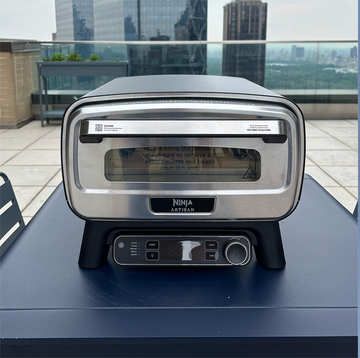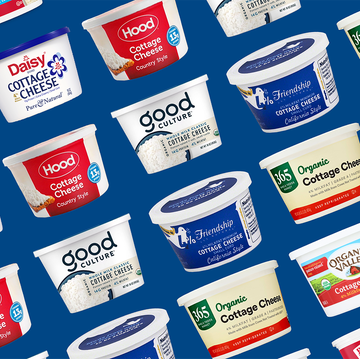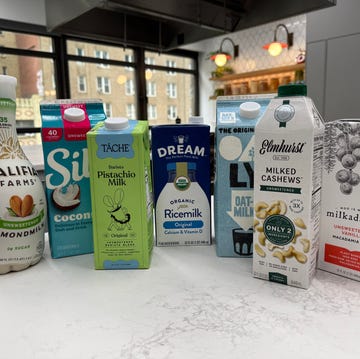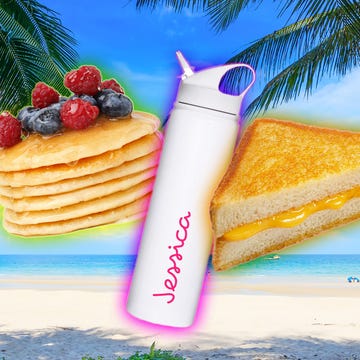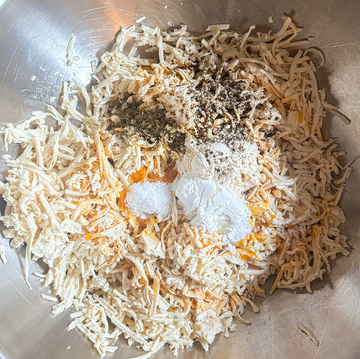It was the Oreo tweet that broke me. The photo shows maybe a dozen Oreos stuffed into a book as milk pours over the scene from above. The caption suggests using the sandwich cookies as a bookmark. Why?
This tweet was the weirdest in months, but Oreo’s feed is otherwise full of jokes and a specifically internet-y meme speak. It’s just one account on the smorgasbord of bizarro voices and imagery from food brands on social media.
Burger King asks Wendy’s to the prom. Vita Coco threatens to send a hater a jar of their urine. Taco Bell argues with White Castle. Wendy’s bullies McDonald’s repeatedly, calling America’s most iconic fast food chain garbage. The Arby’s Instagram account is just cartoons from the Legends of Zelda. Denny’s jokes about existential dread. And this summer found Popeyes, Chick-fil-A, and Wendy’s fighting a battle royale over their chicken sandwiches, leading to one of the most exciting, chicken-depleting moments in Popeyes history.
How did food company social media get so weird? Is it working? And what does it say about us if it is?
Quick, what do you know about Arby’s? I’d say the brand makes roast beef sandwiches and has a hat in its logo. But did you also know that its Instagram account is a constant stream of cartoon characters from anime, manga, video games, and sci-fi series interacting with Arby’s food?
“Back in 2015, 2016, we set about to ask: How can we create some momentum? How can we create content that stands out and still be Arby’s?” remembers Josh Martin, the senior director of social media at Arby’s. “The first thing we tested—we took potato cakes, which are shaped in triangles, and we put three of them in a triangle and it represented the Tri-Force from the Legend of Zelda.” The team then targeted Zelda fans and saw three to four times the level of engagement, by Martin’s estimate, than they got on normal content.
They had found their niche: passionate, deeply devoted young men. Or put another way, nerds. And they found them on their home turf: the internet. “When we post something they really enjoy, they get really excited about it, want to talk about it, want to share it,” Martin says. “That's kind of a measure of success for us: If we have a piece of content that ends up getting on a thread on Reddit to a group of these very niche [users], we think that's very interesting.”
It’s a hyper-specific tactic, but one so many brands are using in a broader way. They’re employing meme speak, playing with trending hashtags, chatting in that detached joking style that’s a hallmark of the internet.
“Brands are very much used to one-way communication, right? We create an ad, a perfectly varnished ad, we put it up on the television, and we hope the consumer consumes it,” says Jonah Berger, a professor of marketing at the Wharton School at UPenn and author of the book Contagious: Why Things Catch On. “Social media is not like that. People are expecting more interaction, a little bit of a back and forth. A different tone, certainly.”
He also points out that certain brands get to be weird because they’re the underdog. Like when Wendy’s fights McDonald’s and calls their food garbage. “It's not McDonald's talking to Wendy's that way,” Berger says. “A challenger brand, particularly one that's known for being a little off-beat and quirky, can take a bit more of that tone.”
Indeed, Martin himself refers to Arby’s as a challenger brand. “We're not going to have the budget of some of our other competitors who are able to spend in places like the NFL and sports. But I think this group is very large and has a lot of passion, and we see that with our content.”
Can you remember what you were doing on May 15, 2019? Because Vita Coco’s community coordinator Lane Rawlings was urinating in a jar and threatening to send it to a Twitter troll.
May 15th was the launch of Vita Coco’s “Impossible to Hate” campaign around their new pressed coconut flavor, which was already a giant risk unto itself. “We actually scanned the internet using an algorithm to find the typically most negative people across certain reviews sites,” says Allison Finazzo, the brand director at Vita Coco. “We reached out to roughly 150 people [on Twitter] who'd ever said anything negative about coconut water, and the rest was history. ”
One of those people was Tony, who complained even more about coconut water when they tried to engage with him, saying he'd rather drink Vita Coco's PR person's urine—so they offered exactly that to him.
“You have the chance to respond to someone, a self-proclaimed notorious Twitter hater, with a completely unexpected and potentially controversial clap back. So do you take the calculated risk?” Finazzo says. Of course, she did. “The plan wasn't to go viral by any means. The plan was to get as many people as possible to lean in on Vita Coco and try our new pressed coconut flavor.”
Within seconds of tweeting, Finazzo watched “an insane amount of shares, comments, and direct messages,” most of them positive. When that patron saint of weird food Twitter (and former Vita Coco spokesperson), Chrissy Teigen, engaged with the tweet, it was another marker of success.
And no, her bosses weren’t mad. “We saw that we actually drove purchase intent amongst a younger consumer. And that's the value—the ability to connect [with] more consumers,” Finazzo says.
“One thing about social media is that it's a low cost of entry, in the sense of you can experiment with it every single day. You can experiment with it 25 times a day,” says David Griner, the creative and innovation editor at AdWeek. “Then take what you learn and refine it within 24 hours and do something different.” Getting an employee to make a crude but unforgettable joke in her own office is much cheaper than hiring, say, a spokesperson like Teigen and shooting a commercial.
Finazzo’s not trying to top the May 2019 moment these days...but she’s not not trying. “You can't guarantee that something will go viral, but you can certainly play the odds. So I think we're just going to continue to experiment. Moments of true magic present themselves every single day,” she says. The magic of peeing in a jar in your workplace!
Summer 2019 was spent watching the Women’s World Cup and and waiting in line in for Popeyes’ infamous chicken sandwich. The latter’s wild popularity depleted Popeyes’ supply chain, and the sandwich sold out just eight days after the brand fired off a taunt toward Chick-fil-A. (Chick-fil-A had seemed to passive-aggressively imply theirs was the original chicken sandwich.)
Wendy’s, Boston Market, and Shake Shack later jumped into the #ChickenSandwichWars, and man is it ~wild~ when brands fight with each other. If anyone knows about that bickering, it’s Burger King. The fast food chain has launched seven campaigns in the last four years alone that trolled McDonald’s. In 2017, when Wendy’s discontinued their spicy nuggets, Burger King started responding one by one to Twitter complaints, urging those unhappy customers to try their spicy nuggets instead. One customer did exactly that, then tweeted a photo eating them, thus completing a perfect social media trolling cycle.
“People are usually egging it on. It's not necessarily like a circle around two people beating each other up,” Griner explains about the nature of brand bickering. “It's a little more like a rap battle—everyone's fired up, everyone's cheering it on. It's definitely combative, but no one's going to get punched in the face.” There is a tension, he admits, to wondering how far they’re going to take it.
“We are extroverted, self-deprecating, funny, a little bit out there,” says Fernando Machado, the legendary chief marketing officer of Burger King (he was named the Grand Brand Genius of 2018 by AdWeek). “That's what happens in social media—it gives the opportunity to behave more like people.”
His proudest Burger King social media moment of recent memory isn’t the trolling, though. It’s when they launched a campaign based around a viral hashtag and political cause. “When the team brought the idea to talk about net neutrality, I need to be honest with you...I didn't even know what net neutrality was,” Machado says. “They said, man, you need to know this. Maybe there is an angle for us to be part of this conversation because it's like the top trending topic in the U.S. in every single state, beating even Star Wars. Star Wars!”
The result of this brainstorm lived, actually, in a very political commercial timed shortly after the FCC’s repeal of net neutrality regulations, wherein customers attempted to buy Whoppers but were told they’d have to pay more if they wanted their food more quickly. “The Whopper Neutrality campaign is one of the most shared campaigns in the history of Burger King,” Machado says.
Senator Maria Cantwell even used the campaign in her arguments for net neutrality on the Senate floor. Yep, legislators are now relying on a burger company’s social media to explain their own legislation. It’s both a greater and sadder accomplishment than getting folks to buy chicken fries, wouldn't you agree?
Here’s one that’ll push the hairs up on your neck. “Zoom in on the syrup,” the tweet implored you, and the accompanying image directed you around and around before asking, “has this distracted you from overwhelming existential dread, lol.” Not even a question mark.
“This made me laugh. Loudly,” Chelsea Clinton captioned her retweet of Denny's deadpan tweet, which played off the popular “zoom in” meme, where messages are hidden in images via tiny or tone-on-tone font. At AdWeek, Griner called it the brand’s best tweet ever, while People went larger and said it was “possibly the greatest tweet of all time.” So what genius at Denny’s came up with it?
“It was the agency's idea,” says Erik Jensen, the vice president of brand engagement at Denny’s. “You never really know what's going to hit. I would argue that none of us, when we saw that creative concept, ever thought it was going to light the social sphere on fire like it did.”
The Denny’s tweet is a perfect example of the shift in tone for food companies’ social media toward something like nihilism, particularly over the last two years—which happens to overlap with the Trump administration and a collective meltdown from young people around climate change. “They're trying to find something that resonates with modern people...this is a dark time,” Griner says. “It's not too weird that brands would acknowledge that this is a somewhat dystopian era that we're living in right now. If you try to be positive every day, people would just shoot you down because you're not speaking the modern language.”
Put another way, “I feel like brands have adapted to that. They know that if you come in all sunshine and rainbows and singing about what a beautiful day it is, people are going to tell you to shut the hell up,” Griner says.
If all this arc toward surrealism, with the stated goal of capturing young people who think the planet is melting beneath me and tat life is an utterly meaningless parade of suffering but okay I’ll buy some spicy nuggets seems, I don’t know, heavy, it’s not. In fact, the process is a lot of fun, say the social media staffers.
“I think it's awesome. It's really exciting,” says Machado. “Social media forces me to create content and to go for creative that will grab people's attention and generate conversation, which I just find much more interesting way to market to people.” And yes, the tweeters are often given pretty loose reins to be creative—and creative, and creative—some 30 times a day.
Adapt or die, goes the evolutionary saying, and Finazzo at Vita Coco is happy to keep finding new ways to grab Gen Z by the eyeballs. “It’s fun,” she says, but you need “an element of creative agility.” “The perception of authenticity on social media is evolving faster than we realize, and authenticity amongst this next generation of consumers is demanded,” she continues. “They don't just want it. They demand authenticity from brands they engage with.”
And there’s nothing more authentic than offering up one’s own bodily fluids to the youth, you know?








